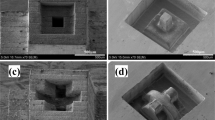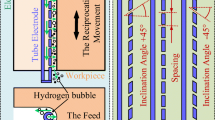Abstract
Microelectrode array has significant and diverse applications in contemporary technology. The most effective method for the precise manufacture of micro-electrode array with specific dimensions is low-speed wire electrical discharge machining (LS-WEDM) combined with workpiece rotation. Workpiece rotation results in the transformation of the machined part from a continuum to a thin-walled array of discontinuities. The change in workpiece structure influences the machining performance. This paper investigates the impact of workpiece thickness and the thin-walled array of workpieces on the discharge gap and burr of LS-WEDM for different materials (copper, copper-tungsten alloy, and pure tungsten). The results show that the discharge gap of thin-walled array depends on the distance between the top and bottom of the workpiece and the number of arrays, while the burr width of thin-walled array depends on the thickness of the individual thin-walled units. In addition, a formula for the discharge gap of a thin-walled array workpiece is given. Based on this, microelectrode array with a side length of 300 μm and a size error of less than 3 μm are prepared on three materials by compensating the machining gaps corresponding to each position, and the surface quality of microelectrode array is evaluated. This study has crucial implications for improving the dimensional accuracy of microelectrode array produced by LS-WEDM.













Similar content being viewed by others
Code availability
Not applicable.
References
A Tanwar H Gandhi D Kushwaha J Bhattacharya 2022 A review on microelectrode array fabrication techniques and their applications Mater Today Chem 26 https://doi.org/10.1016/j.mtchem.2022.101153
J Mateus C Lopes M Cerquido L Leitao D Leitao S Cardoso J Ventura P Aguiar 2019 Improved in vitro electrophysiology using 3D-structured microelectrode arrays with a micro-mushrooms islets architecture capable of promoting topotaxis J Neural Eng 16 https://doi.org/10.1088/1741-2552/ab0b86
Takeuchi S, Suzuki T, Mabuchi K, Fujita H (2004) 3D flexible multichannel neural probe array. J Micromech Microeng 14:104–107. https://doi.org/10.1088/0960-1317/14/1/014
Gong S, Sun Y (2022) Experimental study on forming consistent accuracy and tool electrode wear involved in fabricating array microelectrodes and array micro holes using electrical discharge machining. J Manuf Process 79:126–141. https://doi.org/10.1016/J.JMAPRO.2022.04.046
Li Z, Bai J, Cao Y, Wang Y, Zhu G (2019) Fabrication of microelectrode with large aspect ratio and precision machining of micro-hole array by micro-EDM. J Mater Process Technol 268:70–79. https://doi.org/10.1016/j.jmatprotec.2019.01.009
Jin L, Gong Y, Hu Y, Sun Y (2023) Comparison and evaluation of microchannel array machining with structured cutter. Mater Manuf Process 38(3):314–321. https://doi.org/10.1080/10426914.2022.2105891
Zhang Y, Zhang Z, Zhang G, Li W (2020) Reduction of energy consumption and thermal deformation in WEDM by magnetic field assisted technology. Int J Pr Eng Man-GT 7:391–404. https://doi.org/10.1007/s40684-019-00086-5
Wang Y, Wang Q, Ding Z, He D, Xiong W, Chen S, Li Z (2018) Study on the mechanism and key technique of ultrasonic vibration and magnetic field complex assisted WEDM-LS thick shape memory alloy workpiece. J Mater Process Technol 261:251–65. https://doi.org/10.1016/j.jmatprotec.2018.06.006
Annebushan MS, Kumar DS, Ondrej H, Pavol S, Janakarajan R (2023) Characterization of surface topography during multi-pass WEDM of MWCNT alumina composites. CIRP J Manuf Sci Tec 41:338–349. https://doi.org/10.1016/J.CIRPJ.2022.11.019
Rohilla V, Rachin G, Amresh K, Yogesh K, Neeraj S (2021) Surface integrity analysis of surfaces of nickel-based alloys machined with distilled water and aluminium powder-mixed dielectric fluid after WEDM. Int J Adv Manuf Tech 116:2467–2472. https://doi.org/10.1007/s00170-021-07610-5
Guo C, Wu Z, Wang X, Zhang J (2021) Comparison in performance by emulsion and SiC nanofluids HS-WEDM multi-cutting process. Int J Adv Manuf Tech 116:3315–3324. https://doi.org/10.1007/s00170-021-07600-7
Masahiro Y, Ryuichiro H, Kazuma A, Soichiro M, Tomohiko K (2022) Study on slicing of conductive SiC Ingot by oil and water type WEDM. Procedia CIRP 113:155–159. https://doi.org/10.1016/J.PROCIR.2022.09.124
Aswin P, Mote R (2022) Numerical study of transient thermal profile and thermally deformed tip shape in Wire EDM of narrow angles. J Manuf Process 81:638–654. https://doi.org/10.1016/j.jmapro.2022.07.021
Bhattacharya S, Mishra A, Keshkar N, Kumar S, Kain V, Dey G (2019) Wire electric discharge machining of P91 steel: microstructure and thermal modeling studies. Metall Mater Transa 50A:5336–5355. https://doi.org/10.1007/s11661-019-05445-0
O Dodun L Slatineanu G Nagit A Hrituc A Mihalache I Besliu-Bancescu 2022WEDM-generated slot width variation modeling Micromachines 13 https://doi.org/10.3390/mi13081231
A Conde J Sanchez S Plaza M Ostolaza I Puerta Z Li 2018 Experimental measurement of wire-lag effect and its relation with signal classification on wire EDM Procedia CIRP 68 https://doi.org/10.1016/j.procir.2017.12.035
Chaudhari R, Vora J, Prabu S, Palani I, Patel V, Parikh D (2021) Pareto optimization of WEDM process parameters for machining a NiTi shape memory alloy using a combined approach of RSM and heat transfer search algorithm. Adv Manuf 9(1):64–80. https://doi.org/10.1007/s40436-019-00267-0
Z Chen H Zhou Z Yan F Han H Yan 2021 Machining characteristics of 65 vol% SiCp/Al composite in micro-WEDM. Ceram Int 47 10 13533 13543 https://doi.org/10.1016/j.ceramint.2021.01.212
Sharma N, Gupta K, Davim J (2019) On wire spark erosion machining induced surface integrity of Ni55.8Ti shape memory alloys. Arch of Civ Mech Eng 19(3):680–693. https://doi.org/10.1016/j.acme.2019.02.004
Y Hou J Xu Z Lian C Zhai M Li S Yang H Yu 2022 Research on surface microstructures and properties of NiTi shape memory alloy after wire electrical discharge machining Mater Today Commun 31 https://doi.org/10.1016/J.MTCOMM.2022.103521
D Oniszczuk-Swiercz R Swiercz S Michna 2022 Evaluation of prediction models of the microwire EDM process of Inconel 718 using ANN and RSM Methods Materials 15 https://doi.org/10.3390/ma15238317
Welschof L, Boye G, Klink A, Bergs T (2022) Influence of the WEDM rim zone on material specific thermo-physical properties. Procedia CIRP 113:29–34. https://doi.org/10.1016/J.PROCIR.2022.09.115
M Singh A Singh J Ramkumar 2019 Thin-wall micromachining of Ti–6Al–4V using micro-wire electrical discharge machining process J Brazilian SocMech Sci Eng 41 https://doi.org/10.1007/s40430-019-1827-3
Yan H, Bakadiasa K, Chen Z, Yan Z, Zhou H, Han F (2020) Attainment of high corner accuracy for thin-walled sharp-corner part by WEDM based on magnetic field-assisted method and parameter optimization. Int J Adv Manuf Technol 106:4845–4857. https://doi.org/10.1007/s00170-020-04966-y
Zhang G, Li W, Zhang Y, Huang Y, Zhang Z, Chen Z (2020) Analysis and reduction of process energy consumption and thermal deformation in a micro-structure wire electrode electric discharge machining thin-wall component. J Clean Prod 244:118763. https://doi.org/10.1016/j.jclepro.2019.118763
Y Zhang Z Zhang H Huang Y Huang G Zhang W Li C Liu 2018 Study on thermal deformation behavior and microstructural characteristics of wire electrical discharge machining thin-walled components J Manuf Process 31 https://doi.org/10.1016/j.jmapro.2017.10.024
S Chen 2008 Fabrication of high-density micro holes by upward batch micro EDM J Micromech Microeng 18 https://doi.org/10.1088/0960-1317/18/8/085002
Rakwal D, Heamawatanachai S, Tathireddy P, Solzbacher F, Bamberg E (2009) Fabrication of compliant high aspect ratio silicon microelectrode arrays using micro-wire electrical discharge machining. Microsyst Technol 15:789–97. https://doi.org/10.1007/s00542-009-0792-7
Geng X, Wang Y, Wang Z, Shan D (2010) Experimental study of micro-electrode array by micro-WEDM. Key Eng Mater 455:274–278. https://doi.org/10.4028/WWW.SCIENTIFIC.NET/KEM.455.274
Funding
This study is funded by the Fundamental Research Funds for the Central Universities (N2303001) and the National Natural Science Foundation of China (No.U1908230, No.52005092).
Author information
Authors and Affiliations
Contributions
L.Y. Jin: investigation, methodology, experiment, writing—original draft. Y.T. Hu: experiment. S. Yao and C.Y. Liang: conceptualization. Y.D. Gong: funding acquisition, reviewed and edited the manuscript, supervision.
Corresponding author
Ethics declarations
Ethics approval
The authors state that the present work is in compliance with the ethical standards.
Consent to participate
Not applicable.
Consent for publication
All authors agree to publish.
Competing interests
The authors declare no competing interests.
Additional information
Publisher's Note
Springer Nature remains neutral with regard to jurisdictional claims in published maps and institutional affiliations.
Rights and permissions
Springer Nature or its licensor (e.g. a society or other partner) holds exclusive rights to this article under a publishing agreement with the author(s) or other rightsholder(s); author self-archiving of the accepted manuscript version of this article is solely governed by the terms of such publishing agreement and applicable law.
About this article
Cite this article
Jin, L., Gong, Y., Hu, Y. et al. Experimental study on the influence of workpiece shape on discharge gap and burr in LS-WEDM and the preparation of microelectrode array with specific size. Int J Adv Manuf Technol 130, 5965–5977 (2024). https://doi.org/10.1007/s00170-024-13106-9
Received:
Accepted:
Published:
Issue Date:
DOI: https://doi.org/10.1007/s00170-024-13106-9




